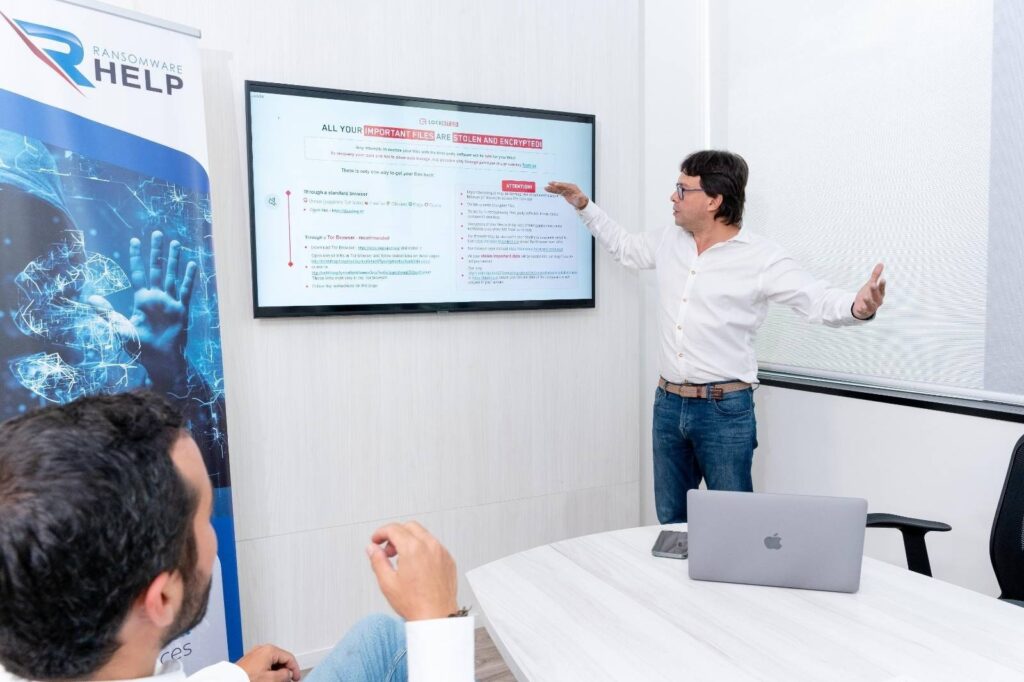Learn how to prevent attacks using ransomware detection technologies. Get the best practices to implement a protection system.

Expert Ransomware Removal
Our certified professionals have over 25 years of experience in ransomware removal, data recovery, and computer security.
What is ransomware detection?
We can use ransomware detection to identify and prevent malicious software, such as ransomware, from infiltrating a system or network.
Monitoring suspicious activity, scanning well-known threats, and analyzing system logs and other data assets for anomalies that could indicate a ransomware attack is all part of the process.
It also includes implementing security measures such as firewalls and antivirus software to protect against a potential attack.
By using ransomware detection tools and techniques, organizations can reduce the risk of suffering a costly ransomware attack.
According to IBM, the average cost of a ransomware attack is $4.54 million.

It does not include the ransom but rather the expense of resources and time.
This data suffices to understand why ransomware detection is crucial within an organization.
How does it work?
Ransomware detection entailsmonitoring the system for suspicious activity and responding appropriately.
It analyzes ransomware behaviors, such as file size, encryption method, infection method, and other features.
The system then searches for anomalies that could indicate the presence of ransomware and notifies the user when one is found.
As also stated on Microsoft’s support page:
‘Ransomware detection notifies you when your OneDrive files have been attacked and guides you through the process of restoring your files.’
Machine learning algorithms also help detect data patterns that may indicate malicious activity.
It aids in quickly identifying new threats before they can cause damage or disrupt operations.
Organizations can protect themselves from ransomware by securing their systems using these methods.
The best way to get the best protection is to contact experts like HelpRansomware technicians, who provide 24/7 complete assistance.
Best practices to implement advanced ransomware detection technologies
By detecting ransomware quickly, organizations can take preventive measures to protect their data and systems from further damage.
Organizations can use ransomware detection solutions to identify malicious files or activities that have eluded traditional security measures.
That helps organizations keeping up with evolving threats and protect their systems from future attacks.
Here are some examples of detection methods:
- Network intrusion detection systems (NIDs);
- Host-based firewalls (HFW);
- Next-generation firewall (NGFW);
- Threat Intelligence feeds on malware;
- Antivirus and anti-ransomware software;
- Data loss prevention software.
Ransomware is a growing threat to businesses and organizations.
It may cause significant financial losses and damage to corporate or personal reputation.
Organizations should invest in advanced ransomware detection technologies to protect against ransomware attacks.
The best practices to implement such technologies on multiple levels of defense are user behavior analytics and updates on the latest cyber threats.
Let us take a look at them individually in the following paragraphs.

Fast & Guaranteed Recovery
HelpRansomware provides a 100% guaranteed ransomware removal and data recovery service, with 24/7 worldwide assistance.
Strong visibility
Strong visibility implies monitoring and analyzing malicious activity and suspicious behavior in the operating system.
Extended visibility helps detect ransomware threats and take appropriate actions in time.
Ransomware detection is a crucial part of strong visibility.
It requires monitoring signs of malicious activity, such as changes in network traffic or file access patterns that could suggest a ransomware attack.
By detecting these threats in time, organizations can take steps to prevent or mitigate the damage caused by the attack.
Segmentation policies
Segmentation policies also help detect and prevent ransomware attacks.
It means dividing a network into multiple segments, each with security protocols and policies.
This helps protect sensitive data from malicious access and reduce the spread of cybercrime.
Organizations can limit the damage caused by ransomware and secure their data by segmenting their networks.
Segmentation criteria can help detect suspicious network activity indicating a potential ransomware attack.
Data published by Help Net Security shows that 96% of organizations claim to be implementing segmentation in their networks.

Sometimes, segmentation criteria are applied to networks.
In other cases, segmentation criteria are applied to data centers.
Each organization approaches it according to its specific security requirements.
For example, it may make more sense for a small organization with little sensitive information than a large government entity with sensitive data stored in many locations.
Intrusion detection systems and malware detection tools
Intrusion detection systems (IDS) and malware detection tools are essential components of an organization’s security infrastructure.
They help detect malicious activity on a network or system, such as unauthorized access, data breaches, and ransomware attacks.
Ransomware detection is critical to prevent the spread of malicious code and protect valuable data from encryption.
IDS and malware detection tools use various technologies to identify suspicious activity.
They include the following methods based on:
- Signature: used for threats we know;
- Heuristics:to identify suspicious file behavior;
- Anomalies: to identify changes in behavior.
With the right combination of IDS and malware detection tools, organizations can better secure their networks from malware intrusions and infections.
Many different types of network-based IDs and ransomware decryption tools are available.
These are typically behavior-based or signature-based tools.
Behavior-based IDs and software detection tools monitor network behavior, such as protocol usage, application usage, and traffic patterns.
They are typically less expensive to implement than signature-based tools because their execution requires low overhead.
Signature-based IDs rely oncomplex, compiled lists of malicious activity and known files to detect malware in real-time while not knowing what is occurring on the network.
Immediate Ransomware Help
Don’t let ransomware hold your business hostage. Our experts are ready to recover your data and secure your systems.
Deception tools
One of the most critical security measures for any company is using deception tools designed to detect and prevent attacks.
In short, they use deception techniques to find ransomware, malware, and other harmful activity.
These tools can spot suspicious activity on networks and systems and detect malicious code or attempts to exfiltrate data.
Organizations can quickly identify potential threats using deception techniques before they become a severe problem.
The deception technology market was valued at $1.8 billion in 2021 and is projected to reach $5.8 billion by 2031, as reported by Allied Market Research.

What tools can help you monitor and detect potential ransomware activity?
Ransomware is malicious software that can disable your computer and deny access to your data unless you pay a ransom.
HelpRansomware specialists alwaysadvise: never pay the ransom!
It is one of the most severe cyber threats today, as it can cause significant financial losses and damage to an organization’s corporate reputation.
Statista’s data indicate that the percentage of organizations victimized by ransomware increased from 55% in 2018 to 71% in 2022.

Therefore, having the right tools to monitor and detect ransomware activity is vital.
There are numerous tools available to assist you in this endeavor.
These techniques typically use advanced algorithms to analyze network traffic for suspicious patterns or activity that could indicate a ransomware attack.
They also alert you when unusual activity is detected to take action and protect your system from further damage immediately.
Furthermore, they help you identify known malicious files and prevent them from entering the system, avoiding any potential ransomware attack.
Ransomware detection techniques
Ransomware is malicious software that locks access to a computer system until payment is made.
statistics on computer attacks report that it is one of the most common attack types.
As a result, understanding the various ransomware detection techniques to protect systems from this attack is vital for businesses and individuals.
In the following section, we will discuss the various techniques for detecting ransomware and how to combine these methods to best defend against ransomware.
Static file analysis
Static file analysis is used to detect malicious code within// files.
It entails scanning files for known malware signatures and suspicious behavior.
As reported by a groundbreaking study conducted in collaboration with Google:
‘A static analysis tool finds bugs by analyzing a system without executing the program.’
This analysis helps detect potential threats before they damage or disrupt a system.
Organizations can use static file analysis to identify and isolate malicious code before it spreads or causes damage.
In addition, it can be used to help organizations develop strategies to prevent future attacks.
File extension blacklist
Common File Extension Blacklist (CFEB) is an essential tool used for ransomware detection.
It is a list of commonly known file extensions associated with malicious software.
This list can help detect and prevent ransomware attacks by blocking files from running for these extensions.
By identifying and blocking these files, organizations can reduce the risk of falling victim to an attack and take immediate steps without remove the ransomware.
CFEB is often referred to as a blacklist, since it includes extensions that could be associated with malware.
However, as it does not contain files, it cannot block access to any files.
CFEB helps find potential ransomware payloads and block their execution in your organization’s system.

Fast & Guaranteed Recovery
HelpRansomware provides a 100% guaranteed ransomware removal and data recovery service, with 24/7 worldwide assistance.
Honeypot files or deception techniques
Honeypot files or deception techniques are ransomware detection methods.
Honeypots are specially designed files containing false information to detect and prevent malicious activity.
As explained by TechTarget:
‘A honeypot is a network-attached system set up as a decoy to lure cyber attackers and detect, deflect and study hacking attempts to gain unauthorized access to information systems.
The function of a honeypot is to represent itself on the internet as a potential target for attackers — usually, a server or other high-value asset — and to gather information and notify defenders of any attempts to access the honeypot by unauthorized users.’
They induce attackers to believe they have found a valuable asset.
Hackers are intercepted, and intrusion is thwarted.
Deception techniques generally entail creating false data on the system, such as bogus user accounts.
The goal is to get intruders to believe they have accessed sensitive information or other valuable assets successfully.
Dynamic bulk file operations monitoring
Dynamic Bulk File Operations Monitoring (DBFOM) is another technique to detect ransomware attacks.
It monitors the file system for suspicious activity, such as creating or deleting a large number of files or identifying unexpected changes to file size.
Monitoring helps identify malicious activity that could be indicative of ransomware.
DBFOM also helps detect other malware and malicious activity like spyware, data exfiltration, and privilege escalation.
DBFOM provides an early warning system by monitoring the file system for suspicious activity.
Measuring changes in files’ data
Measuring changes to files’ data is a method to identify malicious activity that may encrypt or delete files.
It refers to comparing a file’s original data to the current one and looking for discrepancies that could indicate malicious activity.
The principle is simple: if the size of a file changes after it is created, you can assume that the file data has been modified.

Expert Ransomware Removal
Our certified professionals have over 25 years of experience in ransomware removal, data recovery, and computer security.
What are the best practices to detect and prevent ransomware?
To defend against ransomware attacks, organizations must choose the best security solutions to detect and prevent them.
This includes using updated antivirus solutions or advanced technologies, such as Artificial Intelligence (AI), to detect system behavior anomalies.
Organizations should also adopt other best practices like regular patching and backup.
As reported by Gartner:
‘Best practice is to utilize risk-based vulnerability management (RBVM) as the framework into which the patching fits as an enabling process.’
According to the US company’s forecasts and statistics, the future of these practices is not reassuring.
Through 2026, non-patchable attack surfaces will grow from less than 10% to more than 50% of the enterprise’s total exposure.

This will, of course, reduce the impact of automated repair practices.
Organizations can reduce the risk of ransomware attacks by adopting these solutions and training users on safe cyber practices
Organizations in vulnerable areas such as healthcare, education, and public services should be especially vigilant in protecting themselves from such attacks.
How can organizations use advanced cybersecurity solutions to mitigate ransomware risks?
Organizations must take steps to protect themselves from ransomware threats, and advanced cybersecurity solutions are among the most effective methods.
These solutions can detect ransomware before it enters the system, allowing organizations to respond quickly in the event of an attack.
Advanced cybersecurity solutions can also provide organizations with real-time alerts when suspicious activity is detected so that they can react immediately.
By implementing these solutions, organizations can significantly reduce the risk of becoming victims of ransomware attacks.
The reason is that they provide real-time protection against threats and malicious codes.
Moreover, these solutions can monitor user activity and ensure unauthorized software or applications are not downloaded.
If the attack is successful, you can always count on HelpRansomware specialists, experts in removing malware and recovering infected data.
Benefits of early ransomware detection and response
Early detection and response can help mitigate the risk of ransomware attacks and their impact.
Early ransomware detection enables organizations to take action to prevent or mitigate the attack’s impact.
Early detection also enables them to respond quickly and effectively, minimizing operational disruption.
With the right tools, organizations can detect ransomware threats before they cause significant harm.
According to the Fortinet report, less than 40% of businesses have implemented detection measures or response technologies like machine learning.

Early detection and response to ransomware provide improved security, lower costs, and better preparation for future attacks.
Furthermore, you should also consider the advantage of restoring encrypted files more quickly.
A critical component of mitigation is the ability to restore normal operations quickly.
Here are some strategies for preventing and responding to ransomware:
- Awareness by educating employees to recognize ransomware and the tactics used;
- Secure Systems: by implementing adequate security controls to avoid ransomware infections;
- Recovery and restart plan to recover encrypted files;
- Surveillance: being prepared for ransomware attacks, being able to identify it, stop it, and restore operations quickly;
- Secure Internet use: by browsing trustworthy sites and avoiding suspicious ones.
Organizations that quickly and effectively restore normal operations are more likely to sustain minor damage.
Concurrently, they can improve their online reputation and credibility with customers and employees.
Common challenges in ransomware detection
Ransomware detection is an essential part of cybersecurity.
It entails detecting and countering malware to prevent it from taking over a system or network, extorting money or stealing sensitive data.
Common challenges in detecting ransomware:
- Identifying suspicious behavior;
- Detecting unknown variants of existing malware ;
- Keeping up with attackers’ rapidly evolving techniques to circumvent security measures.
Organizations must also ensure their security systems are properly configured and updated to detect new threats.
As suggested by Fortinet, the most significant factors contributing to incidents are:
- Inadequate IR playbooks (78%): the organization lacked the tactical playbooks to detect or mitigate threats;
- Lack of network/system visibility/logging (70%): companies failed to detect initial indicators of compromise;
- Inadequate IR procedures (57%): organizations lacked direction for managing a security incident;
- Inadequate patch management (57%): companies failed to apply patches in a reasonable timeframe, allowing hackers to exploit system vulnerabilities.

In short, the challenge for businesses lies in identifying ransomware before it causes harm.
Employees are the weak link
Employees are commonly the weakest link when it comes to detecting ransomware.
They are potential victims of phishing scams and malicious links, which can lead to ransomware attacks.
Employees may also be unaware of the risks of downloading specific files or clicking on suspicious links.
Therefore, companies must provide adequate security training to their employees.
Awareness programs that help them identify potential threats and take steps to protect their data from ransomware attacks are also critical.
Ransomware attacks spread very quickly
Ransomware attacks are spreading rapidly because social engineering technologies are becoming increasingly influential.
Thus, detecting ransomware is more challenging, as it frequently bypasses traditional security measures.
As a result, ransomware can be transmitted via email attachments, social media posts, and malicious websites.
Malwarebytes’ analysis shows that the most dangerous ransomware in 2022 was Lockbit.

The attackers who use this ransomware typically target automated tools to identify and exploit vulnerable systems quickly.
Some variants leave no traces
Unfortunately, some ransomware variants are difficult to detect since they leave no trace.
In these cases, the victims realize they have been attacked when they receive the ransom note in exchange for the decryption key.
Organizations must take extra precautions to protect their data against this malware.
To do so, they need appropriate ransomware detection tools that spot potential threats to mitigate the risks.

Fast & Guaranteed Recovery
HelpRansomware provides a 100% guaranteed ransomware removal and data recovery service, with 24/7 worldwide assistance.
Why do you need to detect ransomware early?
Malware threats can affect any user or organization, regardless of its size.
Timely detection of ransomware can help organizations reduce the risk of data loss and operational disruption.
Some ransomware detection methods imply:
- Using a network activity monitoring antivirus software;
- Checking DNS records to verify if a new host has been registered;
- Monitoring the traffic in and out of the organization’s network;
- Network port monitoring.
Therefore, timely detection relies, above all, on proactive measures.
It guarantees long-term benefits because the company is prepared to deal with any threat.
Conclusions
When ransomware or other malware affects businesses, they suffer substantial financial or resource losses.
For this reason, organizations must have preventive methods and strategies to counter the threat at an early stage.
From this text, you can draw the following conclusions:
- Ransomware detection allows for identifying and stopping malware, such as ransomware, from infiltrating a system or network;
- $4.54 million is the average cost of a ransomware attack;
- Ransomware detection methods analyze ransomware behavior, including file size, encryption technique, infection method, and other features;
- Best practices for implementing such technologies on multiple levels of defense are user behavior analytics and updates on the latest threats;
- 96% of organizations state they are implementing network segmentation;
- Through 2026, non-patchable attack surfaces will grow from less than 10% to over 50% of the company’s total exposure;
- Less than 40% of companies have adopted detection measures or response technologies, such as machine learning.
In light of such data, HelpRansomware, the world leader in ransomware decryption and encrypted file recovery, is bringing this issue to the attention of companies.
Ransomware victims are increasing as attack methods evolve; as a result, organizations must open their eyes and consider implementing prevention.

Expert Ransomware Removal
Our certified professionals have over 25 years of experience in ransomware removal, data recovery, and computer security.




